So I’ve just spent almost a month in the rainforest and absolutely loved it.
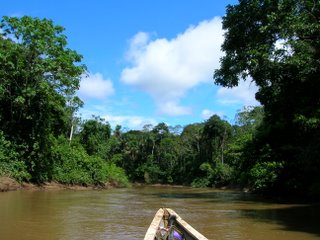
Clare and I were there volunteering at a Jungle Lodge primarily for tourism but which also plays an important role in some research. This research took up our first 6 days.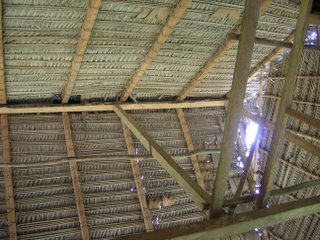
Getting there involved us taking a 9 hour bus from the capital to a big jungle town called Coca. Then took a pallet mobile (rickety all wood thing) for about 3 hours along a pure bumpy road built by oil companies a while back.
Arriving at a bridge we set off in a huge canoe down the river Shiripuno and into a National Reserve of the indigenous people the Huaraoni, a certain few tribes of whom still live as they always did as hunter gathers deep in the forest. 4 hours or so in the canoe we arrived having already seen some cool birds, turtles and 1 caiman on route.
The main research going on is with Butterflies. They have 50 traps set up throughout the forest – 25 hanging close to the ground and 25 up in the canopy. So those 6 days involved carrying heavy buckets of rotting bananas, filling the traps, recording info, lowering and cleaning the traps, checking them and taking any butterflies.
 We just weren’t able to kill the things, so we left that job to Oscar (Oscar is Fernando’s brother and a guy with the knowledge of most of this region of forest including all paths and traps and who also very quickly became a good mate). All this through numerous winding paths and many small trails throughout varying jungle, over streams and through mini swamps.
We just weren’t able to kill the things, so we left that job to Oscar (Oscar is Fernando’s brother and a guy with the knowledge of most of this region of forest including all paths and traps and who also very quickly became a good mate). All this through numerous winding paths and many small trails throughout varying jungle, over streams and through mini swamps.
 The walk for this job lasted at least 4 hours and sometimes up to 6 which would bring you into the harsh heat of the afternoon. The paths – at least for me – were completely confusing mixed with the heat and me being knackered usually after halfway. The trap job started really cool though with us finding a big and real heavy tortoise wandering through the forest on the first day.
The walk for this job lasted at least 4 hours and sometimes up to 6 which would bring you into the harsh heat of the afternoon. The paths – at least for me – were completely confusing mixed with the heat and me being knackered usually after halfway. The trap job started really cool though with us finding a big and real heavy tortoise wandering through the forest on the first day.
I only started to understand all the roots after several walks through them and after extracting Oscar’s knowledge in the form of a map; and a classic map at that indicating locations of cool places like swamps, a hummingbird nest, a nest of green eggs, streams and known sites of animals etc…
Of the various sites our favourite we named “La Isla” (The Island) because you had to cross a river over fallen trees and, when you got across, the vegetation was suddenly really different – it included a huge Ceibra tree, plenty of mud, low plants and plenty of vines and roots. Difficult to explain but it’s just well different to the normal jungle. It’s wild image is stronger because it is the farthest place from the Lodge on the current paths. What also made it our favourite were the animals we would often see and always loads of cool footprints; mostly of peccary and some deer. A lot of experiences with animals in dense rainforest is often seeing tracks, hearing them move or call and sometimes smelling their scents. All this is interesting and exciting when you know they’re closeby but just don’t give you a proper view. Of course the ultimate is to see the animals and we saw plenty, a fair amount of which was quick sitings of them rushing off.
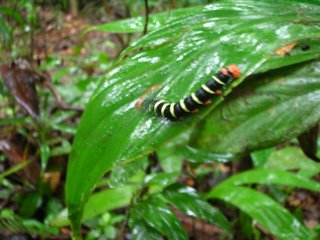
On La Isla, however, we saw great views of the bigger species of the Peccary (White-lipped) and plenty of different species of Monkey.
THE ultimate day for us was a Monday when we were out doing the traps and on route saw a few groups of different monkeys, one of which was pretty feisty and did a good job of intimidating us. We also saw a cool snake (our first here) up close as he was chillin in our path. Later, on La Isla, we were plodding along as usual when all of a sudden Oscar froze and started scampering backwards. An increidle Boa Constrictor was right in our path! A beautiful, shockingly thick and real long (4-5m) snake with fantastic scale patterns which turned red towards the tail. We spent ages admiring it – it just didn’t seem real. Right there in our trail, in a mysterious part of the forest surrounded by bending roots and vines.
 As we silently observed the Boa Oscar pointed up and the coolest looking Monkey was staring down at us from a relatively low and open branch! It was a Monk Saki species which is not how you imagine a typical monkey – full of shaggy black/grey speckled fur, big wide fluffy tail and an undescribable face. There were a few more about bu the view I got of that particular one was just awesome – watching animals with binoculars adds another dimension.
As we silently observed the Boa Oscar pointed up and the coolest looking Monkey was staring down at us from a relatively low and open branch! It was a Monk Saki species which is not how you imagine a typical monkey – full of shaggy black/grey speckled fur, big wide fluffy tail and an undescribable face. There were a few more about bu the view I got of that particular one was just awesome – watching animals with binoculars adds another dimension.
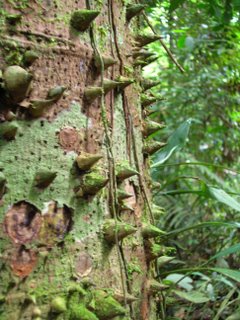
I saw that species several times after that but never such good views and never so tranquil as they’re renowned for fleeing soon after realising they’ve been spotted.
After the first week of doing the trap work we would spend the mornings doing various jobs including making a bench, clearing and making new paths, making signs, putting them up throughout the paths, making a few bridges, trying to teach some English and helping around the cabins. The making of the bench, bridges and paths involved loads of using a machete, which was great fun to learn and practice – boys and their toys eh…
One proper cool one-off job was when I acted as translator for a couple of days. Fernando (the boss) set off up river when a load of food failed to arrive with a group of tourists and after a few days of using up what was left he had to hitch a lift with a passing canoe of lumbermen. 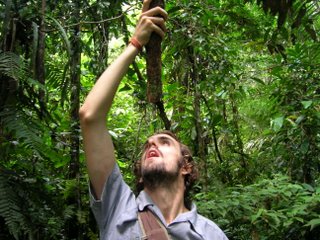
Whilst he was gone a couple of ductch tourists with their motorist, guide and cook turned up looking for him to act as a translator – the guide didn’t speak English and the motorist had been learning (for 2 months!) and was meant to translate. So Oscar suggested I go with them so headed of down river as they were on a camping trip.
I had a cool time learning loads about the plants (including drinking from the water vine) and animals as I was interpreting everything the guide said, had great sitings of animals including various Monkeys, Caiman, cool Frogs and Lizards, Peccary and even a group of 4 Giant Otters right by our canoe on an early morning leisurely trip downstream!
So I learned a hell of a lot about the jungle from everyone – guides, colleagues, local people – and went for sooo many walks (many alone) through the many paths of varying vegetation and scenery.

We thought about it and decided it’s fair to say that we’d see at least a group of monkeys during 9 out of every 10 walks and that’s not to mention squirrels, lizards (one big one about 1m – yellow striped), frogs, incredible insects, other mammals like Peccary, a shocking variety of spiders plus tarantulas, soooo many birds and the odd fish.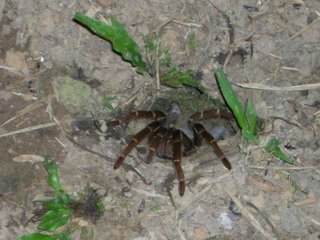

We got into the Naturalist scene as we’d read up on things we’d seen using the books back at the lodge. Most of the frogs I’d find were proper tiny with the exception of a couple – one of which was the very poisonous and huge Smoky Jungle Frog (this pic shows his patterned back).
As well as he walks Clare and I also dabbled in some “artesania”. I attempted to carve a local nut (Tagua) into a tortoise, we made several friendship bracelets, did some drawing and painting and I enjoyed taking loads of photos. As well as the low light levels in the forest, plus the fact that most animals run a mile at the sound/sight or smell of you, there was also the fact that even the smaller animals weren’t keen to pose for the camera. However, some came out ok, many insects…
We also took the little canoe for a paddle a few times…
Leaving the lodge was classic too. A proper case of “sit back and enjoy the show”.
During the canoe ride upstream plenty of interesting birds (colourful parrots, cool tucans, hawks etc) either flew by in front of us or were perched on an open branch.
 Plus we visited a community of the local tribespeople – the Huaorani. They keep a mad range of pets (anything you might find in the forest really) and I saw the hands of a Woolley Monkey which was being smoked on a fire. Their hunting method is impressive – the use a long and damn heavy blowpipe. The pipe, darts and poison are made by them – the poison is gathered from various vines, frogs and other plants. It often just immobilizes the animal (e.g. monkey) so it falls to the ground when the muscles are paralyzed.
Plus we visited a community of the local tribespeople – the Huaorani. They keep a mad range of pets (anything you might find in the forest really) and I saw the hands of a Woolley Monkey which was being smoked on a fire. Their hunting method is impressive – the use a long and damn heavy blowpipe. The pipe, darts and poison are made by them – the poison is gathered from various vines, frogs and other plants. It often just immobilizes the animal (e.g. monkey) so it falls to the ground when the muscles are paralyzed.
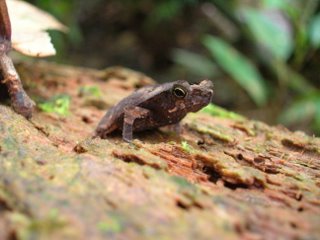
So that was my month in the amazon. Of course there were plenty of other mini tales but you’ve got the idea…
Note: All the photos here will not be included in the Snapfish set. Enjoy.
I think what surprised me most, and ended up being my favourite animals to see, were the rays. On the first boat trip we watched the ‘wings’ of huge Manta Rays flipping about on the sea surface, then soon after we watched them leaping well out of the water and belly flopping or sometimes flipping and back flopping on the surface. Then one passed right by the boat at the surface and i saw its shocking size and beauty as it drifted by. After that we saw rays loads in various situations – often the big mantas jumping and flipping whilst we chilled on the beach. Occasionally, however, we saw beautiful Spotted Eagle Rays swim close to shore and a few times we swam with them including a time when we were snorkelling with loads of Galapagos sharks and Reef Sharks on a day trip and a group of 5 Eagle Rays came along and drifted around proper peaceful. So cool to watch them ‘flying’ through the water. Then there were the smaller sting rays we’d see hiding in the sand in the shallows which were cool to snorkel with and once we saw a school of Golden Rays off a boat – a stunning sight.
Getting between the major islands we took what was probably the worst boat ride experience of my life – thank f*ck it was only 2 and a half hours – and after that dodgy journey we decided on a flight to skip 2 more similar boat trips. The plane was a cool 8 seater with 6 people. I jumped at the chance to ride up in the co-pilot seat like the little child that I am. It was coooool!
















